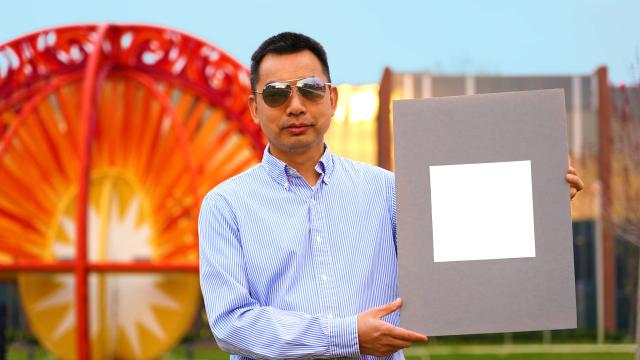If you’ve ever redone a room in your house and gone to the hardware store to pick out some fresh paint, you know that there’s a lot of different shades of white on the market. Turns out, there’s a new shade of white in town — and this one may have some pretty cool (literally) climate implications.
In a study published Thursday in ACS Applied Materials & Interfaces, researchers at Purdue University say they’ve now made the whitest paint on the planet. In creating the whitest paint ever, which researchers say reflects up to 98.1% of light, the Purdue researchers are outdoing their own record, set just last fall, when they developed a paint that reflects 95.5% of sunlight.
It may seem like pointless nitpicking to race to get to the whitest paint of all by just a couple of percentage points when many of us can’t tell the difference between most white sample chips at Home Depot. When it comes to the cooling effects of white paints, though, those little percentages matter.
Anyone who’s gone outside on a hot summer day knows to wear white clothes; white reflects light, while black absorbs. But white paints that are currently on the market with labels like “ultra reflective” or “high reflective” only reflect about 80% to 90% of light, said Xiulin Ruan, a lead author on the study. That may be enough to make your kitchen look sparkling clean on a daily basis — but if we’re talking about cooling properties, it’s less effective.
“We think of 90% to 98% as not very different, but we need to think about the absorption of the sunlight,” Ruan said. “Our paint absorbs 1.9% of sunlight, but those commercial paints, even with reflectants, absorb 10% of the sunlight — five times as much as our paint absorbs. They look white, they are pretty white, but they aren’t white enough — they’re not able to cool beyond the ambient temperature.”
Ruan said that efforts to develop the whitest paint possible that could also act as cooling agents stretch back to the 1970s. Ruan’s team alone has been working on how to get white paints even whiter for around seven years now, hammering out methods of adding reflectant materials to the paint to help it beat back the sun. This successfully white paint incorporates high concentrations of barium sulfate — a chemical compound that’s used to make white cosmetics and photo paper — with different-sized particles scattered throughout the paint.
“The sunlight has different colours, because it has different wavelengths,” Ruan explained. “We need different particle sizes to scatter each wavelength.”
The development of this kind of ultra-reflective paint could be a game-changer for how we design buildings as our world gets hotter and hotter. There’s a growing body of work around how urban design choices — changing out super-hot and super-absorbent asphalt roofs for reflective surfaces, for instance, or building in parks or other green spots in cities to literally cool down the area — can help us beat back the heat in cities and other built spaces without using more energy to power air conditioners.
Ruan and his team have big visions for the paint’s potential; they estimate that using super-reflective white paint on a large scale in cities like Reno or Phoenix could save up to 80% on air conditioning costs. “if you have really hot days our paint alone couldn’t do the job, but on other days it could keep you from turning on your air conditioner,” he said.
These kinds of climate hacks sound like the solution to all our problems — but there’s still a lot of real-world considerations to hammer out when thinking about designing cities to beat the heat. “To make cities more reflective, one has to be very, very, very practical,” said Hashem Akbari, a professor of professor building, civil, and environmental engineering at Concordia University.
Akbari pointed out that regular wear-and-tear on reflective roofs or walls can impact the reflectivity percentages measured in a lab setting. “Soot and dust tend to decrease the reflectivity of the surface,” he said. “If they start with super-duper 95% reflectivity, the pollutants from the air, the droplets, soot could collect on the surface and they decrease the reflectants.”
Still, Akbari said that starting now in regularly replacing roofs, which need updates every few decades or so, with more reflective materials — regardless of the whiteness of the paint you use or the percentage it actually reflects — would be a great start for most cities.
“If every roof that needed to be replaced could be replaced with a highly-reflective roof, within a period of 10 to 30 years all the roofs are going to be highly reflective. You do not have to push a particular technology, like a coating,” he said. “We should encourage marketing and insulation of reflective materials as the roofs are being changed.”
